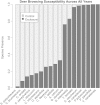White-tailed deer are a biotic filter during community assembly, reducing species and phylogenetic diversity
- PMID: 24916059
- PMCID: PMC4078168
- DOI: 10.1093/aobpla/plu030
White-tailed deer are a biotic filter during community assembly, reducing species and phylogenetic diversity
Abstract
Community assembly entails a filtering process, where species found in a local community are those that can pass through environmental (abiotic) and biotic filters and successfully compete. Previous research has demonstrated the ability of white-tailed deer (Odocoileus virginianus) to reduce species diversity and favour browse-tolerant plant communities. In this study, we expand on our previous work by investigating deer as a possible biotic filter altering local plant community assembly. We used replicated 23-year-old deer exclosures to experimentally assess the effects of deer on species diversity (H'), richness (SR), phylogenetic community structure and phylogenetic diversity in paired browsed (control) and unbrowsed (exclosed) plots. Additionally, we developed a deer-browsing susceptibility index (DBSI) to assess the vulnerability of local species to deer. Deer browsing caused a 12 % reduction in H' and 17 % reduction in SR, consistent with previous studies. Furthermore, browsing reduced phylogenetic diversity by 63 %, causing significant phylogenetic clustering. Overall, graminoids were the least vulnerable to deer browsing based on DBSI calculations. These findings demonstrate that deer are a significant driver of plant community assembly due to their role as a selective browser, or more generally, as a biotic filter. This study highlights the importance of knowledge about the plant tree of life in assessing the effects of biotic filters on plant communities. Application of such knowledge has considerable potential to advance our understanding of plant community assembly.
Keywords: Browsing; herbivory; phylogenetic clustering; phylogenetic community ecology; plant–animal interactions; species diversity..
Published by Oxford University Press on behalf of the Annals of Botany Company.
Figures




References
-
- APG III. An update of the Angiosperm Phylogeny Group classification for the orders and families of flowering plants: APG III. Botanical Journal of the Linnean Society. 2009;161:105–121.
-
- Augustine D, McNaughton S. Ungulate effects on the functional species composition of plant communities: herbivore selectivity and plant tolerance. The Journal of Wildlife Management. 1998;62:1165–1183.
-
- Baldwin B, Sanderson M, Porter J, Wojciechowski M, Campbell C, Donoghue M. The ITS region of nuclear ribosomal DNA: a valuable source of evidence on angiosperm phylogeny. Annals of the Missouri Botanical Garden. 1995;82:247–277.
-
- Balgooyen C, Waller D. The use of Clintonia borealis and other indicators to gauge impacts of white-tailed deer on plant communities in Northern Wisconsin, USA. Natural Areas Journal. 1995;15:308–318.
-
- Beals E, Cottam G, Vogl R. Influence of deer on vegetation of the Apostle Islands, Wisconsin. The Journal of Wildlife Management. 1960;24:68–80.
LinkOut - more resources
Full Text Sources
Other Literature Sources
Research Materials

